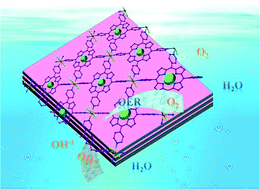Single-atom implanted two-dimensional MOFs as efficient electrocatalysts for the oxygen evolution reaction†
Abstract
The exploration of novel electrochemical energy conversion and storage devices has been extensively studied in recent decades for their specific advantages. Therefore, the design of highly efficient, stable, and noble-metal-free electrocatalysts for oxygen-related reactions (OER) is critical but challenging and is still worth improving. Herein, a facile and controllable synthesis strategy for bimetallic electrocatalysts for the OER from a two-dimensional iron-based metal–organic framework (HUST-8, HUST = Huazhong University of Science and Technology) precursor has been reported. The unoccupied porphyrin center has been disposed into the layer structure of HUST-8, which is very facile for the introduction of a second type of metal center via post-modification treatment. Guided by the synthesis strategy, Fe/Ni, Fe/Co, Fe/Zn, Fe/Mn and Fe/Fe species have been fabricated, and their electrocatalytic performance for the OER has been further characterized, among which the Fe/Ni type exhibits the best efficiency and conversion. For Fe/Ni species of HUST-8 (labeled as Ni@HUST-8), in 1 M KOH, the initial potential for OER activity performance is 170 mV (vs. RHE). At 10 mA cm−2, the corresponding overpotential is 240 mV and the Tafel slope is simulated as 60.8 mV dec−1. All of these experimental results of Ni@HUST-8 illustrate its better performance than commercial IrO2. Compared to the MOF parent and other bimetallic species, the higher electrocatalytic performance of Ni@HUST-8 should be ascribed to the special synergistic effect of Fe and Ni centers, which tends to greatly improve the reaction kinetics and charge transfer efficiency, while increasing the activity of the OER and achieving the best catalytic performances. The systematic investigation clearly manifests the important role of the synergistic effect of bimetallic centers in the OER and provides other insight into fabricating tailored electrocatalysts derived from MOF-based templates.



 Please wait while we load your content...
Please wait while we load your content...
